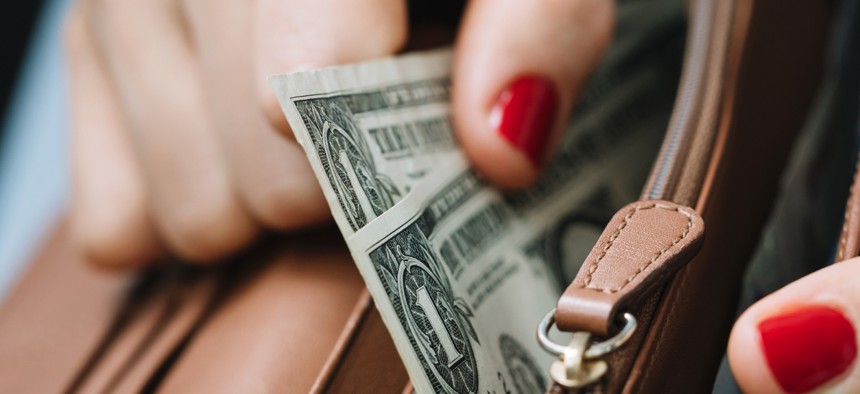In the Rush to Digital, Governments Can’t Leave Behind Cash Payers

iStock.com/Edalin
COMMENTARY | As local and state governments embrace digital payment services, they must ensure that these services are equitable and accessible to all—including people who are unbanked or underbanked.
Even before the Covid-19 pandemic, many state and local governments were undertaking significant changes to both their revenue and customer service operations with new technology. By offering more payment options like web, mobile, cashiering and kiosks, more residents were able to pay for tickets, taxes, utilities and other fees much more efficiently. Despite this, many citizens continued to use in-person payment options—that is, until those services were halted due to the pandemic.
While the shift to digital payments has accelerated in the last year, the momentum toward new technology and online services shouldn’t forget that in-person cash services still matter, perhaps more than ever. Here’s how governments can ensure that new technology innovation doesn’t leave behind cash payers.
Many People Pay In-Person, Often in Cash
According to data from the CityBase platform, even when payers have both online and in-person options, 20%–30% of transactions are still conducted in person. Of those in-person transactions, 30% of individuals and households pay exclusively in cash.
Customers paying in cash are more likely to have low incomes and be unbanked, meaning they have no checking or savings account. Others are underbanked, meaning they have at least one checking account but also use services outside of the traditional banking system, like payday loans or check cashers. In 2017, the FDIC found that 6.5% of U.S. households (8.4 million) were unbanked and an additional 18.7% (24.2 million) were underbanked. These are the same people who have been and will continue to be hardest hit by the pandemic.
We see over and over that these customers take great pains to be compliant in paying their bills. Not only to avoid service shut offs or additional penalties, but also because of pride and dignity. If local governments do not provide safe, convenient, official ways to pay in person, they are likely to see two outcomes: lower and slower revenue collection, at a time when government budgets are stressed, and a poor experience for customers.
When official options don’t exist, customers are more likely to pay their bills using check cashing stores. This subjects them to higher, sometimes predatory, fees. Their payments aren’t posted immediately to their account, which extends the time that they might incur penalties. Service providers lose a valuable opportunity to interact with the customer and have minimal data associated with these transactions. It is critical that local governments ease this burden for some of their most vulnerable residents.
24/7 Kiosks Continue to Safely Serve Customers during The Pandemic
Governments and utilities that provide self-service, in-person payments via 24/7 kiosks were prepared to continue safely serving walk-in customers during the pandemic—without compromising customer experience or burdening the most vulnerable households with extra fees.
One investor-owned utility that has a network of 80 payment kiosks saw that when their payment centers closed due to Covid last March, many of their customers still chose to pay in person. Last April, the utility experienced a 19% increase in kiosk transactions, with 19,700 people paying by kiosk for the first time, indicating that some customers who previously paid via cashier were opting now to pay via kiosk rather than online. Since then, the utility has maintained and increased their pre-Covid volume of kiosk transactions, which now top 85,000 payments per month.
Now, cities that previously lacked self-service channels for their walk-in customers are quickly pivoting to them. We've seen several towns and cities introduce self-service kiosks by using federal pandemic relief funds, since the kiosks help maintain continuous government operations and access to services and reduce the spread of Covid-19 by eliminating person-to-person contact.
For example, the city of Lawrence, Indiana, installed indoor and outdoor payment kiosks at their government center in early fall 2020. The city’s utilities serve more than 14,000 water customers. Before Covid-19 stay-at-home measures, on average 2,000 Lawrence residents paid water bills in person via cashier each month, including 500 cash transactions. Residents can now pay city utility bills 24/7 using cash, check or card, without incurring any service fees.
Modern Technology Equally Important In-Person As It Is online
Just like many local governments are upping their focus and investment in online services, it’s critical to also modernize in-person service. As it relates to payment technology, this means cloud-based, integrated and ideally centralized systems for both cashier-assisted and self-service payment channels.
Real-time integrations improve both the customer and staff experience. Customers gain trust in the payment process because they can immediately see their recent payment reflected against their account. The payment interface can notify the customer of their minimum payment due to avoid penalty fees, provide assurance that they have avoided a cutoff date, or even allow them to opt into a payment plan.
City staff also benefit from having updated information on a customer’s account payment status. Transaction information is readily available if the customer seeks support or wishes to refund the payment. The city receives funds faster and can automate many of the time-consuming activities associated with reconciling their funds. For staff still working remotely during the pandemic, these cloud-based solutions offer secure, streamlined access to do their jobs safely and effectively from home.
Local governments and utilities face the unique challenge of serving every person in the population during a period of major technological transformation. It will serve us all to remember customers’ diverse needs and preferences, and to commit that all people deserve great service and great technology.
Liz Fischer is the chief customer officer for CityBase, where she oversees the company’s client-facing teams. CityBase’s technology helps people find, apply, and pay for public services, and helps staff manage those interactions.
NEXT STORY: DOD works to simplify processes, improve data quality and automate





